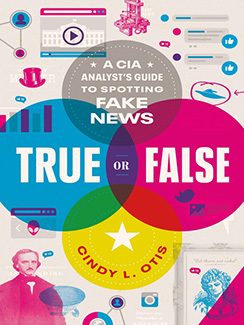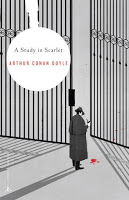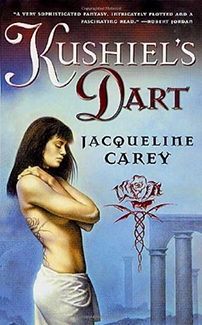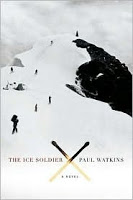I have affiliate relationships with Bookshop.org and Malaprop's Bookstore in beautiful Asheville, NC. I will earn a small commission at no additional cost to you if you purchase merchandise through links on my site. Read more on my affiliate page.

Title: True or False: A CIA Analyst’s Guide to Spotting Fake News
Author: Cindy L. Otis
Genre: Social Issues, Politics, History
Audience: Young Adult
Format: E-book
My Synopsis:
Cindy L. Otis, whose literal job was filtering and verifying news and intelligence reports for the CIA, has written a guide to spotting fake news. She begins with a history of fake news, going all the way back to Ramses II in Ancient Egypt; discusses what fake news is and isn’t; then provides tips and exercises to make it easier for the average citizen to spot fake news him- or herself.
My Review:
In this information age, we find ourselves bombarded with facts or “facts,” as the case may be. A fringe group believing a kooky conspiracy theory may seem fairly harmless but when large swathes of the population believe anything they read that reinforces their own beliefs, we have a huge problem. Consider these sobering statistics:
“The study found that fake news and rumors overwhelmingly reached more people and spread a whole six times faster than true stories. Fake political news, more than any other category of false information on social media, reached more people faster and went deeper into their personal networks.”
Or this one:
“BuzzFeed News also found that the top twenty fake news articles in 2016 got more shares on Facebook than the top twenty real news stories.”
That’s right–fake news gets more traction than real news. I personally find that frightening. Most of us believe ourselves to be well-informed, but are we correctly informed? Probably not as much as we think we are.
Ms. Otis shares examples of how far-reaching the effects of fake news can be. She details the story of the leadup to the Spanish-American war and how publishers wrote blatant lies in order to sell more newspapers and stir up anti-Spanish emotions. It worked but at the cost of a war and the deaths of innocent people. In 2018, townspeople in Mexico circulated a wild rumor that criminals were kidnapping children and killing them for their organs. Shortly thereafter, a mob beat two innocent men and burned them alive simply because they were strangers passing through at the wrong time. Fake news is not harmless or victimless.
Many of the tips were fairly self-evident to me but seeing them presented and organized in this manner made me more aware of my own processes of evaluation. I did find ways to improve my own habits though. I’m terrible about only reading a headline on social media and moving on. Even if that headline is from a reliable source (and I do follow well-established news sites), that’s a bad habit. I can’t possibly know as much as I think I do after reading only a headline. She also suggested that discerning readers should follow news sources with opposing slants. I only follow left-leaning news sources. While reading the book, I decided to start following the Wall Street Journal as well, as a right-leaning yet reliable source. (A friend shared a link to this media bias chart weeks ago if you’re curious about your own news feed. This book didn’t mention it.)
The exercises are primarily image-based so my Kindle Paperwhite was not ideal for looking at those. I’d recommend reading this on a tablet or in print instead for that reason.
People or groups using fake news to influence public opinion will often claim that what they say is the truth, and that every other source of information is lying. The Nazis also played on people’s existing biases and the racism of the time. Fake news is not usually capable of changing our minds completely—it cannot usually get us to believe the complete opposite of what we believed before. Instead, it plays to our existing beliefs and just makes us more certain we are right.
But probably the big problem with a book like this is that the very people who need it most are the ones who are going to view the book itself as fake news. I write this not because they’re more gullible or less-informed; they are simply targeted more frequently. Because fake news was such a huge factor in the 2016 election, the author spends quite a bit of time discussing how other countries leveraged the power of fake news to affect American voters. There are already a couple of reviews of this book on GoodReads opining the author’s “bias against Trump” and “pro-feminist agenda.” (I don’t know what feminism has to do with anything, but whatever.) She admits her own left-leaning bias in the appropriate section but I thought the 2016 election section was remarkably balanced. She tries to stick to the facts as they were and are. But maybe that’s my own bias creeping in.
I definitely recommend this for all readers of any age. This is a hugely important topic that all citizens should learn more about. We’re all susceptible to being duped; we should arm ourselves against disinformation as best we can.
Recommended by:
Deb Nance at Readerbuzz
Similar Books:
If you liked True or False: A CIA Analyst’s Guide to Spotting Fake News, you might also like my review of
- Lies My Teacher Told Me: Everything Your American History Textbook Got Wrong by James W. Loewen
Purchase:
Buy True or False: A CIA Analyst’s Guide to Spotting Fake News from Malaprop’s Bookstore in Asheville, NC.
I have an affiliate relationship with Malaprop’s Bookstore/Cafe in beautiful Asheville, NC. I will earn a small commission at no additional cost to you if you purchase merchandise through links on my site.





4 Comments
Very much needed – they ought to make some kind of documentary on how to figure out fake news — I’ve been duped in the past by fake ads till I spotted the wrong spellings and names of authorities that they used in the ads!
Yes! A documentary might reach more people. And the misspellings were exactly the kinds of things the author said to look out for. CNN for example, might overlook one or possibly two typos (we’re all human) but more than that should be a red flag that you aren’t on a legitimate site or page.
I’m absolutely intrigued by this book. I think you are right though, the people who most need to learn how to discern fake from real news aren’t going to read this book. Thanks for sharing your thoughts
This really should be required reading. I just wish there was a way to get through to the people who need it most.